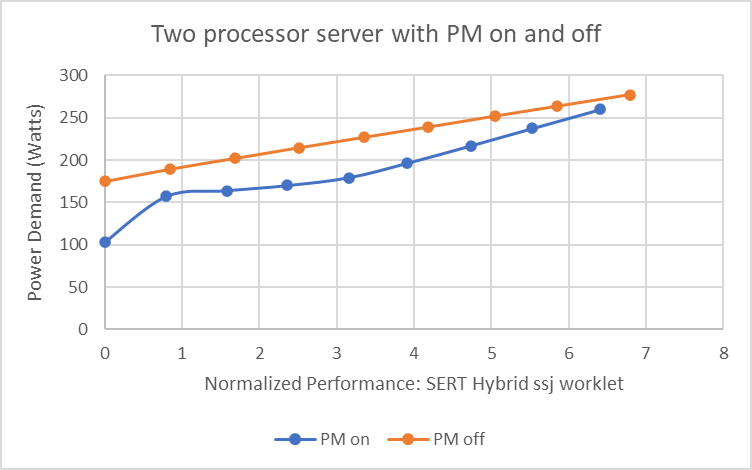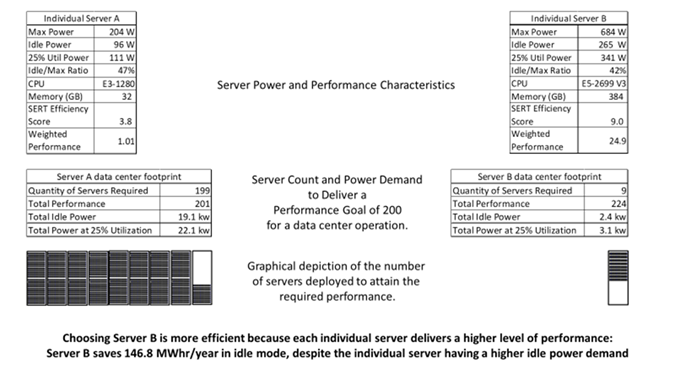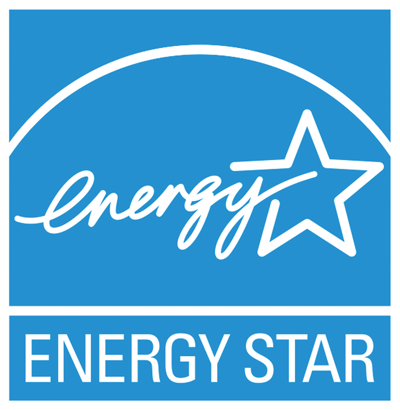April 5, 2021 - By ENERGY STAR
ENERGY STAR’s Certification: The Path to a More Efficient Data Center
Over the past 12 years, manufacturers of computer servers have shown leadership through the ENERGY STAR® program to improve server energy efficiency and help reduce data center energy consumption. Computer servers that earn the ENERGY STAR label meet minimum power supply efficiency levels and Server Efficiency Rating Tool (SERT™) overall efficiency scores (normalized work delivered/watt) and offer enabled power management features. ENERGY STAR has informed server buying decisions for U.S. federal, state, and local government procurement and corporations by enabling the assessment and comparison of servers based on their work delivered per unit of energy consumed – a key indicator of server efficiency.
How Does SERT Work?
The SERT overall efficiency score, developed by the SPECpower Committee, evaluates both a server’s work capacity and power demand when delivering a given workload – a higher score indicates a more efficient or productive server. The SERT tool assesses performance and power demand at 4 utilization levels for 6 CPU worklets, 8 utilization intervals for one CPU worklet and at 2 intervals for 2 memory and 2 storage worklets. These measurements provide insight into the server’s ability to reduce its power demand as the server workload is reduced and are combined through a weighted geometric mean calculation to provide a representative single value score that can be used to compare the efficiency of different server products and configurations.
The Benefits of Enabling Power Management
Table 1 and Figure 1 provide data on two SERT tests for a single server configuration with power management (PM) on and off. The table and graphic illustrate two key points.
- Power management enablement reduces server power demand, improving the SERT score. Power demand is reduced at each of the eight tested utilization intervals (figure 1) in the Hybrid ssj worklet. The SERT score for the server with power management on is improved by 13.2%, 26.5 vs. 23.4, as compared to the server with it off. The SERT score clearly differentiates the relative efficiency of the two different server configurations (based, in this case, on the chosen power management setting) and illustrates that the server with power management on uses less power to deliver a largely comparable performance in comparison to a server with power management off. The SERT score can provide similar comparative efficiency assessments for multiple servers from different manufacturers, helping data center operators identify the most efficient server options.
Power management settings can reduce server performance and increase response/latency times to levels that cannot be tolerated by some applications, such as those with short, bursty workloads or applications that support financial markets where any latency delay is unacceptable. It is estimated that 60-80% of applications can tolerate the increased latency associated with manufacturer-provided power management settings.
- Enablement of power management settings significantly reduces the idle power demand for a server. In the example in Table 1, the difference in idle power is 72 watts (-41.3%). Assuming the server is idle 80% of the time and the cost of electricity is $0.10/kwh, the power-managed server would save 500 kwh and $50 per year. In a large data center, these savings translate into hundreds of thousands of dollars a year.
Table 1: Configuration details and key power, performance, and efficiency score metrics for the EPYC Server

Figure 1: Normalized performance vs. power demand for a two-socket rack server

The Use of SERT Data to Estimate Data Center Power Demand
The SERT measurement data can also be used to compare the power demand required by different servers to meet a given data center workload capacity. Figure 2 provides an example that dramatizes how server workload capacity affects data center energy consumption. The SERT measured performance data can be combined to get a weighted performance (figure 2) or a geometric mean (table 1) of the maximum CPU performance. Using the example in figure 2, the weighted performance data can be divided into a performance goal to determine the number of servers of a given configuration needed to deliver the goal. That number of servers can then be multiplied by the power demand at a given performance point (idle, 12.5% ssj interval, 25% CPU worklet interval, etc.) to estimate and compare the installed power demand of the number of chosen servers. In the example, the higher workload capacity server (server B) requires fewer servers and lower power demand than the lower powered, lower capacity server A. The deployed power analysis enables a data center operator to select the server product that minimizes data center energy use.
Figure 2: Deployed Quantity of Servers needed to deliver a specified performance goal

ENERGY STAR certification and collected SERT measurement data offer data center operators an overall efficiency assessment and performance and power information to help them make informed server buying decisions which can reduce data center energy consumption and save on facility energy bills while meeting workload requirements.
ENERGY STAR published three ‘Ask the Expert’ (ATE) articles in January 2021; ‘How to Measure Server Efficiency with SERT™’, ‘How to Save Idle Energy in Computer Servers’, and ‘How to Do More With Less Using Deployed Power Analysis’. These three articles provide an explanation of the Server Efficiency Rating Tool (SERT), a discussion on how to reduce server energy consumption at low server utilizations while maintaining desired performance levels, and the use of SERT measurement data to identify the optimal server work capacity and power demand to minimize your data center energy consumption. They are supported by four ITI Green Grid reports that provide technical data and analysis using examples from a SERT measurement dataset compiled by ITI Green Grid.
 The ENERGY STAR® data center equipment program has been focused on increasing data efficiency for 14 years. The program has focused on identifying more efficient data center equipment – servers, storage products, uninterruptable power supplies, and large network equipment – that delivers more work per unit of energy consumed. Ryan Fogle, ENERGY STAR Datacenter Product Development and Marketing Manager, John Clinger, Energy and Sustainability consultant supporting the ENERGY STAR Datacenter program and Jay Dietrich, an ITI Green Grid Invited Expert managing the Green Grid collaboration on the ATE articles, worked in partnership on this publication and the ATE series to promote ENERGY STAR products and industry efforts to enhance data center efficiency.
The ENERGY STAR® data center equipment program has been focused on increasing data efficiency for 14 years. The program has focused on identifying more efficient data center equipment – servers, storage products, uninterruptable power supplies, and large network equipment – that delivers more work per unit of energy consumed. Ryan Fogle, ENERGY STAR Datacenter Product Development and Marketing Manager, John Clinger, Energy and Sustainability consultant supporting the ENERGY STAR Datacenter program and Jay Dietrich, an ITI Green Grid Invited Expert managing the Green Grid collaboration on the ATE articles, worked in partnership on this publication and the ATE series to promote ENERGY STAR products and industry efforts to enhance data center efficiency.
Read These Related Articles:
- Data center company Digital Realty receives EPA recognition for cutting emissions
- 2018 Energy Star Award winners announced
- Vermont passes energy efficiency 'backup' bill
- Verizon targets 48 MW of green power by 2025
- GM, Merck, Sears among more than 40 C&I names recognized by Energy Star for sustained excellence
Stay Up-To-Date












